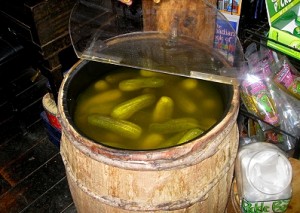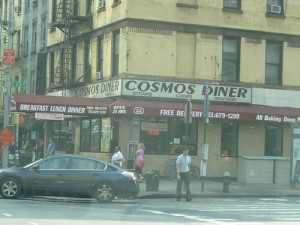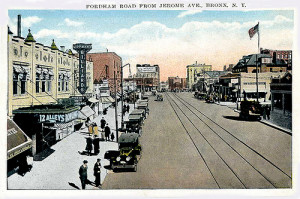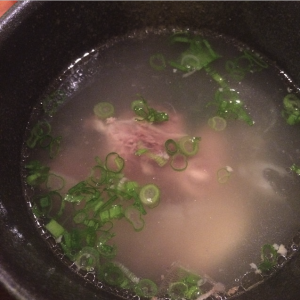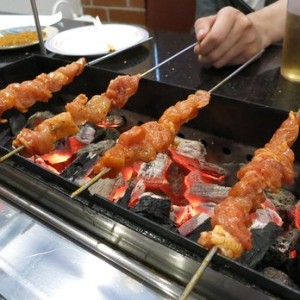You will never find a cucumber, cooked, fresh or pickled, on an Italian menu. For some strange reason, Italians believe cucumbers have a near lethal effect on the digestive system. Oh, well, that only means more cucumbers for the rest of us. Cucumbers make a very superior cold soup, perfect for summer. Cucumber slices with lemon juice and dill are perfect with many German and Scandinavian dishes. Chopped cucumber (and radish) should always be added to cold beet borscht or cold sorrel soup (schav). Chopped cucumber, radish, scallions, lemon juice are added to Greek yogurt in order to make the Indian salad, Raita, which can cool down a blazing vindaloo curry. Cucumber slices with sour cream (or yogurt) and lots of dill is a happy companion of cold poached salmon. These are a few of the good things HG does with fresh cucumbers. But, it is when art is applied to cucumbers, the vegetable becomes a pickle, and few things in life are better than a good pickle. Sour (and half sour) Jewish pickles with their inimitable dill and garlic taste, are the necessary accompaniment to pastrami, corned beef, chopped liver and a host of other kosher (or kosher style) delicacies. French cornichons are a delight to consume with country pates, saucisson and other masterpieces of French charcuterie. Slightly sweet “bread and butter” pickles (the Bubbie’s brand is the best) are nice with sandwiches. In HG’s Bronx youth, the hungry lad evinced a passion for pickles. HG bought them straight from the barrel at the “appetizing” stores that were a fixture in all Jewish neighborhoods. HG never ate popcorn at the movies. Instead, HG munched a pair of sour pickles. Tasty. Healthy (low in calories). Cheap. They cost a nickel in HG’s youth.
Cukes
October 13th, 2015 § 0 comments § permalink
Uli Monaco (1935-2015)
September 24th, 2015 § 1 comment § permalink
One of the depressing aspects of old age (HG will be 86 in November) is the passing of long time friends. Two years ago it was Peter Meyerson, the gifted TV comedy writer who was HG’s uproarious companion in irreverent mirth for almost 60 years. Earlier this year, Nir Baraket, the esteemed Toronto photographer, HG/BSK’s friend for some 50 years, died. And, last week Uli Monaco died. HG met Uli (she was then Uli Beigel) at Bennington College in 1954. Uli was 19, very original, very bohemian and very talented. HG and friends all had literary ambitions. It was Uli who realized those ambitions. Her early short stories were published in Mademoiselle and the New Yorker and collected in book form as Victoria At Night and other stories. We were all thrilled to see her very young face (with its usual expression of slightly amused irony) adorning the back cover. For whatever reason, that was the last fiction Uli ever published. She went on to motherhood (three children) and a long marriage to HG’s friend Donald Monaco (who survives her). Uli had an extensive career in pharmaceutical and medical public relations. She was always vague about her career. HG only knew she was well paid and very respected in the field. Uli had a razor sharp wit and a powerful intellect. It seemed brutally unfair that such a mind be assaulted by Alzheimer’s. Uli was not in good shape when she and Donald managed to get to New York two years ago for HG/BSK’s 50th Wedding Anniversary Party. It wasn’t easy for Uli but she was there to help HG/BSK celebrate. That was the last time HG saw Uli. HG (and many, many others) will miss her.
Old Fogey Food Memories
September 22nd, 2015 § 0 comments § permalink
Mimi Sheraton, who is one of HG’s favorite food/restaurant writers (she was the NY Times restaurant critic for many years), once recalled the chow mein she ate in Brooklyn restaurants during her youth: “I still remember the mild soothing taste of that food, primarily the flavors of celery, bean sprouts and onions. It is far removed from the sophisticated (and truly better) Chinese food now fashionable, but there are moments when I would trade six of the best Szechuan meals in town for one plateful of that old chow mein (pronounced ‘sharmane’) nostalgia.”) The quote is from Sheraton’s book, From My Mother’s Kitchen. an indispensable guide to Jewish family cooking. Yes, HG shares her chow mein nostalgia. HG often enjoyed the terribly messy but strangely appealing chow mein sandwiches dispensed by the Nathan’s Famous hot dog emporiums in Coney Island and Manhattan’s Seventh Avenue. Years ago, HG and gourmand companion Charles E., would meet for a stealthy lunch in a dimly lit Sixth Avenue Chinese restaurant. They would devour “combo platters” of chow mein, fried rice and greasy egg rolls. Like illicit lovers, they would leave the restaurant swiftly and furtively to avoid being seen by friends with elevated dining tastes. Yes, nostalgia has a kick: A week or so ago, a ferocious north wind was battering Prince Edward Island. Outside, the windows of HG/BSK’s home revealed a sea topped with a froth of whitecaps. For some obscure reason, the tumultuous weather made HG remember the plain-spoken comfort food HG enjoyed decades ago in New York bar-and-grills, diners and coffee shops: Corned beef and cabbage with boiled potatoes on Third Avenue (when the El rumbled overhead). Open faced pot roast sandwiches drenched in rich brown gravy. Ditto open faced turkey and roast beef sandwiches (accompanied by mashed potatoes and cranberry sauce or insipid vegetables). liver and onions topped with bacon. Salami and eggs served “pancake style.” Spaghetti (never al dente, always overdone) with big meatballs and “red sauce.” A simple “bowl of red”–chili topped with raw onions and grated cheddar. BLT’s on whole wheat toast with loads of mayo. That night BSK and HG devised a PEI dinner that provided comfort: Grilled weissurst (veal) sausages with sweet mustard. Sauerkraut. Boiled local potatoes. Yellow bean salad. Gahan’s PEI ale. There was a fire in the Danish stove and sounds of Mozart. The winds did blow. The sea surged. And HG/BSK (and Toby, The Wonder Dog), were snug in their comfort zone.
Christ Cella – Never Forgotten
September 5th, 2015 § 7 comments § permalink
Christ Cella was a New York steak house on E. 44th Street. It opened in the 1930s and closed in the 1980s. Its glory years were the 50’s, 60’s and 70’s. Later, it was just a shadow of its former glorious self. On June 29, 2011, HG wrote about CC in a post entitled: “Gone But Not Forgotten Restaurants.” Well, CC certainly remains in the memory of many people. Not a week goes by without someone (including friends and relatives of staff who worked at the restaurant) contacting HG and sharing thoughts and memories of the restaurant. Older folks, veterans of Madison Avenue and the communications industry, recall happy three martini and steak lunches. The younger set remember joyous meals with their dads before sporting events. Even members of the Cella family have reached out to HG to recall the joy of the restaurant. HG ate there alone, with friends and when entertaining journalists HG wanted to influence. Every meal was a pleasure. The Christ Cella proprietors demanded the very best product. They and their customers were willing to pay (for the time) comparatively steep prices in order to get it. And, the kitchen crew treated the fine ingredients with respect and precision. When HG ordered a New York strip steak rare, HG received a steak that was charred on the outside and robustly red in the interior. Rare, not raw as is the fashion for steak in Paris. HG’s spring favorite of shad with shad roe and bacon was perfect, Never overcooked. The lemon butter sauce enriched the the fish and roe but never overwhelmed the fresh flavors. And, the bacon was crisp with nary a spot of grease. The boiled potatoes with parsley were just right. The Christ Cella emphasis on quality might be the reason it is remembered with such fondness.
Bronx Memories – Keep it Personal
August 28th, 2015 § 5 comments § permalink
HG has many fond memories of boyhood in The Bronx (a boyhood that took place more than seven decades ago). It was a very Jewish borough. Yes, there were substantial Italian, Irish and African-American enclaves but Jews were in the majority and the borough culture had a very Jewish tone. Affluent Jews lived on the stately avenue, The Grand Concourse (official name was Grand Concourse and Promenade). GC was the dividing line defining class and economic status. Working class to the east. Lower middle class to the west. HG always loved to walk GC from Kingsbridge Road to W. 161 st. Much to see. The little cottage on Kingsbridge where Edgar Allan Poe lived and wrote for a short period of time. Alexander’s Department Store on the corner of Fordham Road. Loew’s Paradise movie theater with its ornate interior and ceiling of sparkling stars. (It was near W.183rd and across the street were two culinary destinations—Sutter’s Bakery and J. S. Krum soda fountain and confectionary). Also on GC was the Ascot movie theater. It was an intimate movie house with a demure facade. It was here that young HG sat in the upper balcony, puffed cigarettes and watched great foreign films like “Grand Illusion” and “Blue Angel.” There was a lingerie shop nearby with window mannequins bedecked in fashionable bras and girdles (As can be imagined, young HG gave this enraptured attention). Further south were beautiful white brick art deco apartment houses (many with entry facades decorated with fanciful mosaics). There was also the dignified Andrew Freedman home for impoverished gentlefolk (fronted by a meticulous green lawn). Other landmarks were the lofty Lewis Morris Apartments where many doctors had their offices and the Concourse Plaza Hotel where teams playing the Yankees often lounged in the lobby before and after games. West 16lst Street concluded HG’s stroll. The striking art deco Bronx County Court House on GC and off to the west, Yankee Stadium on River Avenue. Nearby was the Earl movie theater (striking facade), the Jerome Cafeteria, the great Addie Vallins soda fountain and Nedick’s hot dogs. Excellent nourishment was always close at hand in The Bronx of yesteryear. The broad east-west shopping streets (Kingsbridge, Fordham, Mt. Eden, Burnside, W. 167th, W. 170th, W. 16lst contained splendid Jewish delicatessens, bakeries, “appetizing” stores (stores that specialized in smoked fish, pickles, olives, etc.). There were some good cafeterias (but few restaurants). And, of course, plenty of butchers, fish mongers and green grocers for the industrious home cooks. The Bronx was a borough of apartment dwellers. In the low rent areas, tenants treated the sidewalks as extensions of their living rooms. In warm weather, men in their undershirts played cards. Women chatted and overlooked the play of lively children. Little HG and his pals played relentlessly. Punchball. stickball, “association” football, “stoop” ball, ring-o-leevio, hide and seek, johnny-on-the-pony, kick the can. Later, there was softball, basketball and sandlot football. (HG was a sandlot backfield star and played in tough games throughout the borough. There was ethnic rivalry plus the teams bet on themselves, winner take all. The ref held the money. Many fist fights. A good preparation for the often rocky game of life that lay ahead). The Bronx was a Democratic Party fiefdom James J. Lyons was Borough President and Ed Flynn was “The Boss.” A smooth functioning machine that paid close personal attention to its constituents. An example: HG was a bright, obedient elementary school student, always receiving A’s for academic excellence and conduct. After the final term report card, HG’s parents would receive a letter from Borough President Lyons. It read in part: “Your son Gerald’s excellent school performance has come to my attention. You must be very proud. Congratulations. I am sure the fine home you provide has aided Gerald in achieving success.” HG’s mother treasured these letters and preserved them in a special folder (alas, destroyed in a fire years later). She would have walked over hot coals in order to get to a polling place and vote the straight Democratic ticket. During BSK’s years as a Colorado political strategist, BSK mentioned these letters to Democratic Congressman Ed Perlmutter. “Make it personal, Ed. Make it personal.” Ed followed her advice. He has never lost an election.
Depression Era Rockaway
August 22nd, 2015 § 2 comments § permalink
For a few years now, Rockaway, the proletarian beach peninsula that stretches off Brooklyn and Queens, has become one of the coolest spots in New York City. Peter Hellman, HG’s pal (Hellman is a brilliant journalist, wine expert and author of many books), was a pioneer in discovering it as a great surf spot. Now Rockaway is filled with surfers and scores of boards rest on the the boardwalk newly restored after the devastation of Hurricane Sandy. Lots of restaurants lure hipsters (NY Times recently did a story on Tacoway, an innovative Mexican joint). Rundown houses (sold at steep prices) are being renovated as second home retreats. SJ, the Jamaican music retailer/archivist/impressario/deejay, does a few reggae shows at a beach venue every summer. And, that’s HG’s definition of super-cool. The new Rockaway bears little resemblance to Depression-era Rockaway where HG and family escaped from the steamy Bronx from July 1 to the end of the Labor Day weekend. HG has written many posts about the primitive, cramped but joyous boarding house lodgings occupied by the family (rent was $35 for the summer). The boarding house was on B. 114th Street, a very Irish Catholic neighborhood. Nine-year-old HG, the only Jewish kid on the block, had a rude welcome. A dozen fights. Then, a grudging acceptance. HG was the unquestioned star of the tough football games played on the beach. HG captained the team when the 114th Street kids challenged the hated guys from 113th Street. HG’s pal, Jimmy Rourke, insisted HG wear a Catholic Miraculous Medal. Didn’t want HG to be the target of dirty play if a Jewish identity was revealed. HG complied. The 114th Streeters won. Many happy memories, Fireworks every Wednesday night. Concert (every two weeks) by the boys from the nearby Catholic orphanage. The orphans were shepherded for their ocean swimming by stern nuns. Little HG was beguiled by the head to toe voluminous bathing costumes worn by the swimming nuns. Reidy’s Bar and Grill was on the corner (it was where HG would fetch a pail of cold beer for the family dinner). HG had his first romance with the proprietor’s daughter, Peggy. The cute freckle-faced miss gave HG a first kiss. Unforgettable. Gave HG a lifelong predilection for freckles (witness BSK). During those Depression years folks managed to live without television and other electronic miracles. They made their own entertainment. A few times every summer boarding house tenants put on an amateur musical entertainment–a house party. HG recalls Gaelic step dancing, tap dancing, banjo and ukulele strumming. Lots of song. HG’s Mom got applause for a romantic song about the Isle of Capri. But, the big hit was older sister Beulah’s rendition of “When Irish Eyes Are Smiling.” Little HG provided a moment of unconscious comedy (long a part of family legend). For some obscure reason, HG fancied himself a singer. HG entertained the crowd with an a Cappella version of “Paper Doll.” The totally off key version produced roars of laughter. HG was puzzled but accepting. End of musical career. Of course, the best thing about Rockaway was the sea. Little HG was in and out all day. Swimming. Body surfing. Splashing. The beach was crowded. Wall to wall people. Little HG found it festive. Fun by the sea has always been part of HG’s life. Fire Island, Nantucket. Vancouver. And, now, Prince Edward Island. As HG writes about these memories, HG looks out at sun shining on a serene, warm sea. Beautiful, empty beach dotted with the radiant bodies of HG’s grandchildren frolicking, BSK taking in the sun, EM paddling a kayak. Farewell memories. Time for a swim.
Happy Sausage Discovery
August 19th, 2015 § 0 comments § permalink
HG has often written about the wonders of grilled Italian sausages (with fried peppers and onions, of course) that were sold off the back of trucks in New York’s Greenwich Village many decades ago. Sausage and peppers are always on the menus of traditional Italian restaurants in New York and New Jersey and are served to the crowds at the feast of San Gennaro in Little Italy (an area that is losing its ethnic identity as it has evolved into a tourist enclavein the middle of an encroaching and vibrant Chinatown). Unfortunately, when you leave New York/New Jersey the quality of Italian sausages diminishes. Supermarket products are loaded with nitrates, filler and have a nasty flavor. Whole Foods sausages have good ingredients but the spicing is pallid. HG has checked online sources with modest success. Some Italian New York butchers will send sausages to HG’s New Mexico kitchen but only in thirty to sixty pound orders. That’s a lot of salciccia. Pat La Frieda, the eminent New York gourmet butcher (in business since 1922) offers a 3-pound batch (‘from Grandfather’s recipe”) for $40 (plus shipping). Quite pricey. The 6-pound batch is a better deal at $62. There are times on Prince Edward Island when HG wants to vacation from seafood and dive into the food of HG’s Greenwich Village youth when apartments rented for $30 a month and artistic young women wore black leotards. It may be sentimental nostalgia, but HG wants to eat sausage and peppers. Happily, HG made a fortunate discovery as HG examined the meat case at McPhee’s Supermarket in Souris. There, HG found all natural Italian sausages from Fingal, Ontario. Three brothers, Mark, Brian and Jason Caughell raise healthy pigs: grain fed, no antibiotics, no growth hormones. And, the sausages have no chemicals or other adulterants. HG thought: Give them a try. If the taste is insipid, invigorate them with hot pepper flakes and fennel seeds. Last night was the big test. BSK fried peppers and onions with a bit of garlic in good olive oil. A splash of wine vinegar to complete the cooking. Prepared penne with parmesan. Sliced a very superior John the Baker baguette from the Cardigan Market. HG assumed responsibility for the sausages. Six sausages were popped into a pot of boiling water. The heat was turned off and the sausages were left to poach gently until the water returned to room temperature. The sausages then went on the gas barbecue grill and were cooked carefully until they were crisp and dark brown. HG and BSK dug in with knife and fork. Silence. Then some happy smiles. This was the real deal. Sausages that brought back memories. Viva Ontario!! Viva brothers Caughell !!
Masterful Maiko
August 17th, 2015 § 0 comments § permalink
Yes, HG is obsessive about food. At the end of one meal, HG plans immediately the next culinary experience. Not a harmful obsession (except, possibly, for the waistline). Far less harmful than monetary greed, lechery or a lust for opiates. HG’s family shares HG’s interest (if not obsession) with dining. And, HG benefits from the fact that they are all excellent cooks. HG’s role is to play the dual roles of Enthusiastic Feeder and Indulgent Critic. While HG loves SJ’s barbecue (and chicken gumbo), Lesley R.’s pasta dishes and seafood stews, BSK’s pork chops, smashed potatoes, poached eggs and other classics, it is Exquisite Maiko who brings cuisine to a lush and lofty level. Every EM dish is not only sublimely delicious but is composed as a visual treat, a work of art that provides pleasure to both the eye and the palate. Over the past few nights there were some typical EM performances which resulted in two of the best meals HG ever ate: For the first, there was a minimum amount of calories (happily) because HG’s appetite (and consumption) was even more robust than usual. These were the elements of the meal. EM’s signature of lightly sautéed sole filets flanked by steamed bok choy and adorned with garlic chips and bonito flakes. Eggplant was grilled and then marinated in sake, soy sauce, garlic, ginger, sesame oil and broth. Tiger shrimp sautéed with ginger, garlic, sesame oil and a tiny bit of butter. Dusted with smoked Spanish paprika (for a bit of heat). Bowls of fluffy rice. It is useless to detail EM’s recipes. They are dependent upon a combination of professional knife skills, intuitive timing and Japanese aesthetics. HG (and family) are the happy and admiring beneficiaries.
For the second amazing meal, HG was reminded of a blazingly hot late July day in New York some 50 years ago. HG and a very pregnant BSK (baby due next month) were shopping for baby furniture and other necessary equipment at Macy’s. Herald Square was an inferno. The tired and famished duo sought refuge at nearby Keen’s Chop House, a favorite restaurant. A strange choice, since the venerable restaurant specialized in hearty wintry fare like mutton chops, roast beef, steaks, Yorkshire Pudding, etc.. However, the restaurant air conditioning was functioning nicely. The dark oak paneling and antique lights created an Old-London-In-Autumn atmosphere. Cool and comfortable HG/BSK devoured great slabs of tender, rare roast beef with Yorkshire Pudding and leaf spinach. Fiery horse radish and English mustard on the table. Cold English ale. A very satisfying meal on an improbable day. HG recalled this meal at dinner on Prince Edward Island as the day was unusually hot, humid and sticky. EM found oxtails at a local supermarket so the inventive chef brewed hearty oxtail soup, big chunks of oxtail floating in rich broth enhanced with chopped scallions, herbs and Ponzu. Lightly marinated crisp Napa cabbage was added to the dish and a sprinkling of Japanese hot pepper mix. The meat was tender with a nice slightly gelatinous texture. The broth was invigorating. The discomfort of the day was banished. Somehow, a delicious comfort level was achieved. Finally, a cooling breeze swept over the dinner table and the happy group finished the meal with a platter of EM’s Mo Po Tofu. Delicious. Thanks, inventive EM, for defying the conventions of hot weather cooking.
Russian Ambivalence
August 15th, 2015 § 3 comments § permalink
Midday. HG sipped BSK’s savory sorrel soup and thought of schav the sour and tangy ice cold soup HG’s Mom served on steamy New York summer days. Mom’s soup was a variation of schi, a favorite Russian soup that is made with sorrel and spinach in the summer and cabbage (or sauerkraut) in the winter. Mom also made beet borscht in the summer (always served with a dollop of sour cream) and either a boiled potato or cottage cheese mixed with chopped onions and radish. Winter was time for kapusta, a very filling cabbage and beef soup. Chicken soup was enriched with a ladle of the Russian staple, kasha (buckwheat groats). Smetana (sour cream) is eaten with virtually everything in Russia and Mom followed that custom. All of her cooking was a blend of Russian and Jewish flavors but since she learned to cook from her mother in Belorussia, she favored Russia. HG’s father drank tea Russian-style: a sugar cube clenched in his teeth (sometimes cherry jam was added to the tea). HG’s father home brewed Russian cherry brandy, vishniak. Cherries, soaked and aged in sugared vishniak, were a special treat. (Seven-year-old HG once raided a bowl and had HG’s first, but not last, tipsy experience). Vodka was never seen in HG’s home. Presumably, the family associated it with Russian peasants, Cossacks and violence. The spirit of choice, besides vishniak, was Park & Tilford rye whiskey. HG’s father always had a robust shot before dinner and poured a tiny snifter for little HG (thus beginning a very pleasurable lifetime custom). Yiddish and English were spoken in HG’s home but Mom and Dad switched to Russian when they discussed subjects forbidden to children (sex?). HG’s father was profoundly anti-Communist. A Socialist and a youthful member of the Jewish Labor Bund, he hated Stalin and always called him the Momser (the bastard). “Der Fuhrer Hitler” and “the Momser Stalin”, in his eyes, were equally evil mass murderers. During HG’s youth, HG was more sympathetic to Stalin and Russia. HG cited Russia’s support of the Spanish Loyalists during the Spanish Civil War, the American Communist Party’s battles against racism and the fact that Russia, alone in Europe, was a bulwark against anti-Semitism. HG’s father shook his head and said HG had a good heart but was deceived by Stalin’s propagandists. Just wait, young HG was advised, you will learn the truth about Stalin (“that monster momser.”) Of course, HG’s father who had no formal education but much labor union experience, was correct. Stalin was a monster, responsible for the death of 10,000,000 Ukrainians by famine during his agricultural collectivization program and the death of untold millions of Russians in purges and gulag imprisonment. His destructively wrong headed strategy toward Germany during the early days of World War Two cost millions of Russian lives and could have led to a to a total German conquest of Russia. HG has been immersed in thoughts about Russia since a recent reading of “A Writer At War: A Soviet Journalist With The Red Army, 1941-1945” by Vasily Grossman. A superb war correspondent and great novelist (“Life and Fate” about the siege of Stalingrad), Grossman is particularly moving in depicting the courage of Russian soldiers, often poorly lead (they died by the millions but they defeated the better organized, technically superior Germans). Grossman personalizes combat through the intimate depiction of the participants. A critic described Grossman as “a perceptive observer with an eye for detail.” No writer, in HG’s opinion, has ever had a better grasp of what Grossman called “the brutal truth of war.” His journalistic masterpiece is probably his description of Treblinka, the Nazi death camp (874,000 Jews were murdered there and 2,000 Gypsies). Grossman’s precise detailing of the camp’s operations is a chilling, horrible piece of Holocaust history. After describing one almost inconceivable horror, Grossman writes:”It is infinitely hard even to read this. It is as hard to write it. Someone might ask:’Why write about this, why remember all that?’ It is the writer’s duty to tell this terrible truth, and it is the duty of the reader to learn it. Everyone who would turn away, who would shut his eyes and walk past would insult the memory of the dead.” Given his humanism and his passion for the truth, Grossman became a political outcast in the Soviet Union. It was ruled his novel “Life and Fate” could not be published for over 200 years. In 1961, KGB officers broke into his apartment and seized every copy of the manuscript plus carbon paper and typewriters. However, Grossman had left a copy with a friend and it was eventually smuggled into Switzerland. Published worldwide, it was acclaimed as one of the greatest Russian novels of the twentieth century. It was published in Russia only as communism itself collapsed. Grossman died of stomach cancer in 1964. He was 59, living in poverty. His earlier works were removed from circulation and he believed his great work had been suppressed forever. If you have not read Grossman, do so. He is a treasure.
Casual Culinary Treats
July 27th, 2015 § 0 comments § permalink
HG/BSK attended the Rollo Bay Fiddle Festival near the town of Souris on Prince Edward Island. This is a two day event, the ultimate ceilidh, a celebration of Scottish and Irish music featuring scores of fiddlers, pipers, singers, step dancers and musicians from all over the Island, Nova Scotia and Cape Breton. Wikipedia defines “ceilidh” as: “Traditional Gaelic social gathering involving playing Gaelic music and dancing. Originated in Ireland and Scotland.” The Rollo Bay event is joyous with lots of folks arriving in motor homes from distant points. In addition to the music, HG/BSK enjoyed a unique treat: Scallops on a stick. These were sea scallops breaded in a spicy mix, quickly deep fried and skewered. Dazzling. Reminded HG of other wonderful, casual, often unexpected treats. As a very little boy in Depression era southeast Bronx, HG enjoyed sweet potatoes (with a big pat of butter) cooked by an old man in a charcoal stove on wheels. In that same time period, hot chickpeas doused with chicken fat were dispensed in paper cups. These were winter treats. In the summer, Italian vendors sold chunks of fresh coconut and sweet ices. During HG’s later New York days, HG sneered at “dirty water” hot dogs but loved the wondrous Italian sausages with peppers and onions served on crusty bread and cooked on the back of Greenwich Village trucks. HG encountered some great snacks during international travel. Hot chunks of garlic sausage were sold with robust bread and mustard on the streets of Prague (just months after Czechoslovakia became a democratic country). There was another interesting treat in that beautiful city: “Vaffels.” A window would open in a nondescript building. A sign was hung: “Vaffels.” A crowd would gather. And, out would come the treats. Warm waffles covered in bittersweet chocoate syrup and fresh whipped cream. The cost: Five cents American money, Preposterously delicious. Possibly the best of all street treats are the northern Chinese BBQ carts in the Flushing section of Queens. Truck pulls up at a corner with a retro-fitted charcoal oven. Old lady begins laying out various meats, veggies and seafood over the smoking coals. Dusts them in a mysterious blend of cumin, hot pepper and other spices. Served on a wooden skewer. She’s famous. There’s a long line. Worth the wait. Best chicken in the world.
